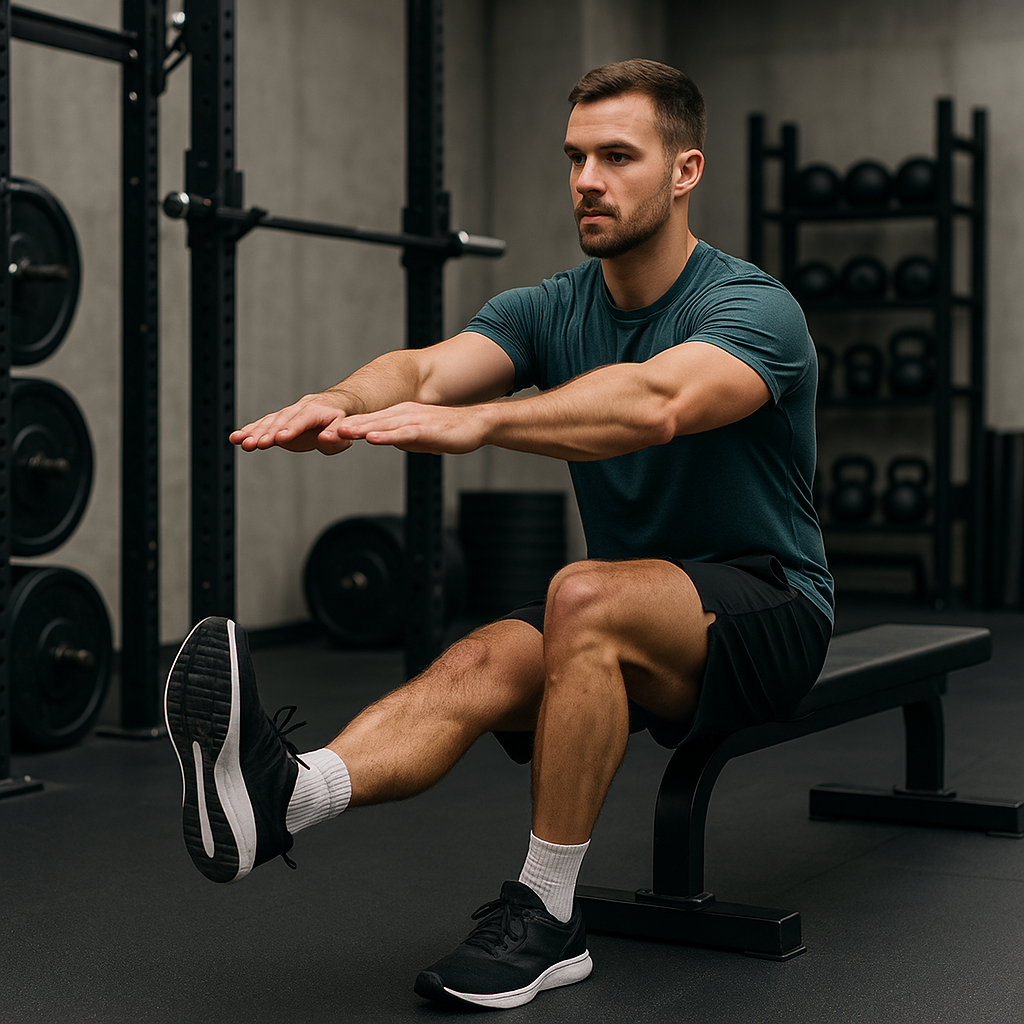As a fitness coach, working with runners of all abilities, one of the most common mistakes I see is treating running as though it’s purely aerobic, as though the only “training” you ever need is more miles. Running is a high-impact, repetitive activity that places enormous stress on muscles, tendons, joints, and connective tissues. Over time, even small asymmetries or weaknesses can become injuries.
One of the most important extra intervention runners can adopt to protect themselves over the long term is this:
Strength training (systematic, progressive, targeted) is not optional — it’s essential.
The argument: risk of injury in runners + what strength can do
Running is not benign
Every time your foot strikes the ground, your lower limb, pelvis, and core absorb and redirect forces. Over a long run or season, your tissues are exposed to repetitive load, especially tendons, ligaments, muscle fascia, and joint cartilage. Many running injuries are overuse injuries, not one-off traumas.
Common problem areas include:
- Knees
- Shins/tibia
- Ankles/calves
- Achilles/midfoot
- Hips/glutes
- Lower back
Weaknesses or imbalances in muscles (hip abductors, glutes, core, calves, foot intrinsic muscles) can lead to altered biomechanics, abnormal loading, and compensatory stresses elsewhere.
It is well-documented in running injury literature that prior injury, high weekly mileage, sudden increases in training volume, and poor biomechanics are risk factors.
What strength training offers
Strength training can counteract or mitigate many of those risk factors. Here is what it brings:
- Improved muscle capacity and resilience
By increasing the force-producing capacity of muscles and their ability to absorb load, strength training helps muscles act as “shock absorbers” more effectively. - Better tissue adaptation
Tendons and connective tissue respond to mechanical loading (within limits). Progressive resistance can stimulate adaptation (e.g. increased tendon stiffness, improved collagen remodelling) that helps them cope with repeated stress. - Enhanced neuromuscular control & stability
Strength training helps not only by becoming “stronger,” but by improving the timing, coordination, and control of movements. Small stabiliser muscles (hip abductors, core, ankle stabilisers) can be trained to activate better and faster, reducing stray movements or excessive joint motion. - Correcting asymmetries or imbalances
Many runners develop side-to-side discrepancies (leg strength, glute dominance, etc.). A targeted strength programme can identify and remedy those imbalances before they become problems. - Supporting fatigue resistance
Toward the end of a run, when fatigue sets in, form tends to degrade, and the weaker links in the kinetic chain become exposed. Having strength reserves gives you a buffer. - Indirect performance benefits
When done carefully and not overdone, strength work can improve running economy, efficiency, and speed. (This is often a nice “side benefit” when the primary aim is injury resilience.)
What the evidence says (and doesn’t say)
It’s important to be honest: while strength training is widely advocated in coach, physiotherapy, and running circles, the empirical evidence is still developing. Some studies show protective effects, and others are inconclusive.
Although the evidence is not yet definitive, it is promising, especially when strength programmes are well designed, supervised, and adhered to consistently.
Why some studies fail to show a benefit
Why do some trials come up “no difference”? A few reasons:
- Poor adherence / low compliance. If runners don’t stick to the strength plan rigorously, the effect is diluted
- Insufficient dose or volume. Too low a stimulus
- Unsupervised or poorly executed exercises. Poor form or low quality undermines the benefit
- Short time frames. Some studies run for only a few months, which may not capture long-term adaptation
- Confounding factors. Nutrition, rest, biomechanics, external load variations
The most consistent protective effects are found when programmes are supervised by a professional and adhered to.
So, while we can’t guarantee zero injuries, the weight of theory, clinical experience, and emerging evidence supports making strength work part of your running foundation.
A runner’s mindset shift: strength is not “extra”. It’s necessary.
Runners need to reframe how they think about strength. Some common mental barriers include:
- “Strength training will make me bulky/slow.”
- “I don’t have time. My priority is running miles.”
- “I need to rest my legs; lifting will interfere with recovery.”
To each of those:
- Proper strength work with moderate loads and controlled reps is unlikely to create bulky muscle in endurance runners. The stimulus is modest, and the goal is resilience, not hypertrophy.
- Your priority might be running, but that doesn’t mean strength is optional. It’s like a foundation under a house: if the foundation cracks, the house is compromised.
- Done intelligently (on off-days or paired with easy runs, with proper scheduling), strength work need not impair recovery; indeed, it can support recovery by improving muscular robustness.
In other words, we’re not talking about heavy bodybuilding sessions. We’re talking efficient, targeted strength for longevity.
Practical design principles: how to build a runner-friendly strength programme
- Start with baseline mobility & control
Before loading heavily, ensure the runner has basic mobility (hips, ankles, thoracic spine) and movement control (single-leg balance, pelvic stability). If you bypass this, you risk reinforcing poor movement patterns.
- Prioritise functional, multi-joint movements plus stabilisers
Compound lifts like squats, deadlifts, lunges, and single-leg work are essential. But equally important are targeted stabiliser & control exercises: glute med/abductors, core anti-rotation, ankle stabilisers, and foot-intrinsic elements.
- Emphasise unilateral & asymmetrical work
Because running is inherently single-leg in stance, unilateral strength (step-ups, single-leg RDLs, Bulgarian split squats) helps reveal and correct side-to-side imbalances.
- Use progressive overload, but intelligently
Over weeks, gradually increase load (weight, reps, sets) or complexity (pause, tempo variation). But don’t rush, the connective tissues need time to adapt.
- Include eccentric control & deceleration training
Eccentric (lengthening) loading is crucial because many injuries occur on the deceleration phase of movement. Incorporate exercises like eccentric calf lowering and slow single-leg negatives.
- Integrate neuromuscular / proprioceptive elements
Balance, stability drills, and plyometric or jump drills (in moderation) help the neuromuscular system react under varying loads.
- Periodise relative to run training
Your strength programme should ebb and flow with your running training phases. During heavy mileage or very intense cycles, volume in strength may reduce; during base or off-season phases, strength volume can increase.
- Ensure recovery & avoid overtraining
Allow rest days, manage fatigue, and avoid overloading on strength when legs are already taxed.
Case for injury prevention: mechanisms in action
Hip/glute weakness → ITB / knee pain
Suppose a runner has weak glute medius. With each step, the pelvis drops slightly, the knee alignment shifts, and the IT band or lateral knee structures take abnormal load. By strengthening glute medius and external rotation control, you reduce that drift, improving alignment and reducing irritative stress.
Tired calves/Achilles under load
Late in a run, calf muscles fatigue and lose stiffness. The Achilles tendon is absorbing more shock than intended, and microtrauma accumulates. A strength program that includes eccentric calf lowering, loaded calf raises, and single-leg work helps tendon resilience.
Core & lumbopelvic instability
Suppose your core, obliques, and pelvic stabilisers can’t resist torsion or rotation under load. In that case, compensatory rotation travels up and down the chain, often irritating the lower back, hip flexors, or even adductors. Anti-rotation core work, controlled planks, Pallof presses, and single-leg stability drills mitigate those stresses.
Addressing common questions & myths
“Does strength training slow my running performance?”
No, when done correctly. In fact, many runners see improvements in economy, efficiency, and speed over time. The key is to manage volume, avoid excessive hypertrophy, and synchronise strength training cycles with your running.
“Will it make me bulky?”
Unlikely. Endurance runners are not in a hormonal or nutritional environment conducive to major hypertrophy. The loads and volume here are modest, aimed at resilience, not size.
“I don’t have time/gym access.”
You don’t need fancy equipment. Many effective exercises use bodyweight, dumbbells, resistance bands, or minimal kit. Even 30–45 minutes, 2–3 times per week, can make a difference.
“My legs are too tired after runs — I can’t lift.”
You don’t always have to lift heavy. On tough running days, shift strength work to lighter loads, focus on control, mobility, or core/stabiliser work. Or schedule strength on lighter run days or cross-training days.
How to begin (for runners new to strength work)
Here’s a roadmap:
- Movement screening – check single-leg stability, hip control, ankle mobility, and core bracing.
- Begin with a minimal “foundation” circuit – bodyweight lunges, glute bridges, planks, calf raises, and side band walks.
- Progress slowly – after 4–6 weeks, add load, increase sets, progress to unilateral variations.
- Include eccentric, stabilisation, and control drills – as described above.
- Monitor load and fatigue – don’t pile strength on top of very heavy running days.
- Evaluate, adapt, periodise – adjust strength volume and intensity in different phases (base, build, peak, recovery).
- Stay consistent – benefits accrue over months and years, not days.
Strength training is not a magic bullet. Some runners will still experience injuries, especially if they overload mileage too fast, skip rest, or have underlying structural issues (anatomical alignment, weak bone health, etc.). Also:
- The evidence base in elite runners is thin. Many studies target recreational or novice runners; applicability to high-mileage, highly trained athletes is less certain.
- Some injuries stem from acute incidents, missteps, or non-muscular causes (e.g. foot biomechanics, terrain, shoe choice).
- If poorly programmed (too much too soon), strength work can be another source of overload.
However, the balance of risk and reward strongly supports incorporating strength training, particularly when it’s planned and executed with care.
Why runners must do strength work (and how to make it sustainable)
Let me summarise the key points:
- Running places repeated stress on the musculoskeletal system; overuse injuries are common.
- Strength training builds resilience: stronger muscles, healthier connective tissue, better neuromuscular control, and improved fatigue resistance.
- The scientific evidence, while not yet conclusive, leans in favour of strength for injury prevention, especially when programmes are supervised, adhered to, and well executed.
- The key is not volume but intelligent design: purposeful, progressive, movement-based strength, balanced with running training.
- Runners should begin with a foundation, incorporate unilateral work, emphasise eccentric control, and periodise alongside their run plan.
- Do not expect miracles overnight. Durability develops over months and years.
- But taken together, this is one of the most effective “insurance policies” a serious runner can fold into their plan.
If you’re a runner who’s had one injury after another, or you feel like you’ve reached a ceiling on how much training your body can handle, adding a strength plan is one of the best interventions you can make.



